"A fact is a simple statement that everyone believes. It is innocent, unless found guilty. A hypothesis is a novel suggestion that no one wants to believe. It is guilty, until found effective." -Edward Teller
The idea of black holes has gone from a curious thought experiment to a theoretical likelihood to a near-certainty -- with thousands of known candidates -- in a very short time.
But never before have we been able to image a black hole directly; all we have are artists' renditions of what they might look like.
And for the first time ever, all of that may be about to change.
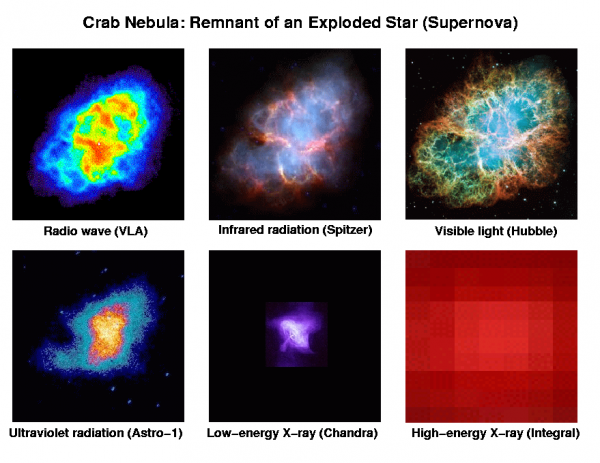
Above is a series of images taken of a star that exploded -- more or less -- about 1,000 years ago. And you'll notice that the infrared, visible light, and X-ray images are far superior in quality to the others (e.g., the radio). It isn't just this object (the Crab Nebula), either. Take a look at the supernova remnant from Cassiopeia A.
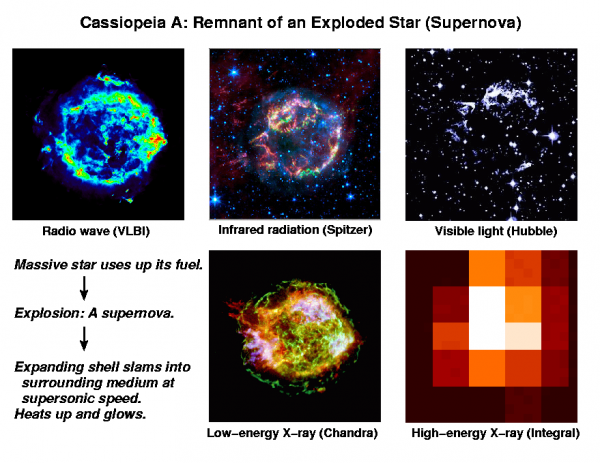
Hmm... this looks a little different; this one doesn't have way lower resolution in the radio than in the IR, visible, or X-ray. What's going on? Let's start by explaining the lower-resolution image.
- The infrared (from Spitzer), the visible light (from Hubble), and the X-ray (from Chandra) images are all taken from space, where there is no atmospheric distortion to contend with. Despite incredible recent advances in adaptive optics, observing from space will always be superior -- all other things being equal -- to observing from the ground. And...
- X-ray, visible, and even infrared light is much shorter in wavelength than radio waves.
Why should this second thing matter? Let's take a look at a good radio telescope.
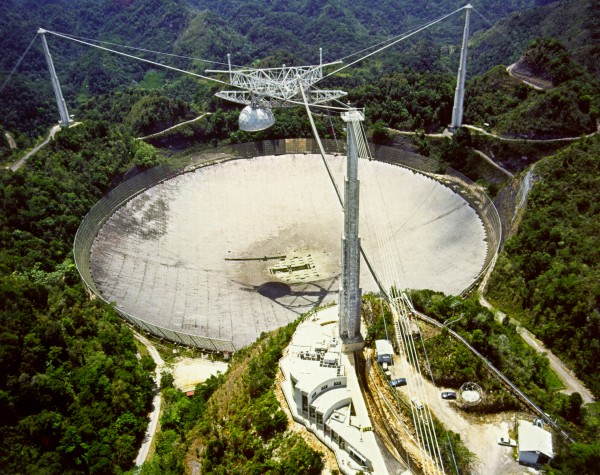
This telescope -- in Arecibo, Puerto Rico -- is huge. That is, in fact, a mountain that the primary mirror is built into. With a diameter of 1,000 feet (or over 300 meters), it is about thirty times the size of the world's largest optical telescopes.
And yet, it is far less powerful. Why's that? Because radio waves are huge! While visible light has a wavelength such that one million wavelengths could fit across you from shoulder to shoulder, you could fit about one radio wavelength in that same span.
And that's what determines your resolution: how many wavelengths across your telescope's primary mirror is.
But radio telescopes can do something special in a way that no other type of light can.
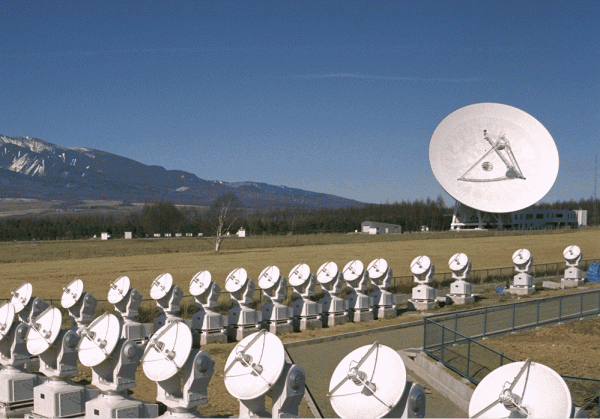
Instead of building one giant dish, we can build two (or more) small dishes a great distance apart. If their observations are synched up, and they observe the same object at the same time, we can use the technique of astronomical interferometry to "see" with a resolution equivalent to the distances between the telescopes!
In principle, building a huge dish that same size would still be better, because in addition to the resolution, you'd also get the huge increase in light-gathering power, which you don't get for building multiple small dishes. So it's like looking up at the sky with incredibly sharp eyes, but you're wearing very dark sunglasses; that's the trade-off. But this interferometry trick is true for all wavelengths of light. In the visible part of the spectrum, the twin Keck telescopes (below) have taken advantage of this for more than a decade.
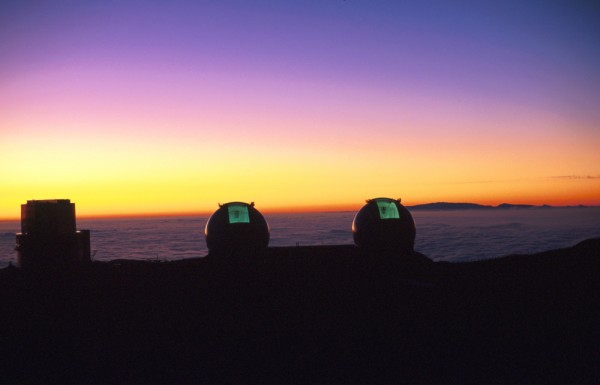
But radio can go one step further. Due to difficulties synching these telescopes' observations together, the optical telescopes (above) need to be relatively close together, as you can see. But thanks to a technique developed by Roger Jennison in the 1950s using atomic clocks, radio telescopes can be placed incredibly large distances apart.
And this gives us not just interferometry, but a special type known as VLBI, or Very Long Baseline Interferometry. What does the ability to do this mean? Let me show you.
In 2004, the European-VLBI Network took an image of a radio source, above. As you can see, the resolution isn't so great. But using this VLBI technique, which can take data from telescopes on opposite sides of the Earth, i.e., with a baseline of thousands of kilometers, allowed us to obtain the highest-resolution image of all-time.
With a resolution many times superior to that of the Hubble Space Telescope already, radio astronomy using this VLBI technique is already the best in the world in terms of resolving bright, point-like radio sources.
Well, if you wanted to see a black hole, and you were living here on Earth, where would you look?
You'd go and look for the closest, largest, most radio-loud-and-active black hole to us. Which is in the heart of the nearest large cluster of galaxies to us: the Virgo Cluster. At "just" 53 million light years away, the galaxy M87, living deep inside the Virgo Cluster, has a black hole that's more than a thousand times as massive as our own, and it is active.
Let's take a look with the Hubble Space Telescope to see what I mean.
That's pretty spectacular, isn't it?! But using radio-VLBI techniques, we have already obtained resolution of this active black hole (and the emitted jet) that is fifty times greater than Hubble can give us. Want to see?
The "1 pc" bar indicates a distance of just about three light years, and remember this thing is over 50,000,000 light years away!
But if we wanted to image this black hole directly -- in other words, to see with resolution so good that we could resolve the event horizon of the black hole -- we'd need a much bigger interferometer than the Earth can give us.
How could we make that happen?
You send a giant radio telescope out into space. As long as you can send an atomic clock with it and synch it up with telescopes on the ground, you can use this same technique. Only, instead of thousands of kilometers, you can make the interferometer distance hundreds of thousands of kilometers!
Well, guess what launched on Monday?
The Russian Radio Telescope, RadioAstron, went up into space aboard this Zenit rocket, launched from Kazakhstan! (Story also at Wired and New Scientist.) And in order to get the longest possible baseline from this rocket, you know where it went?
Out as far as the Moon! Over its five-year mission, it will achieve a maximum distance of 390,000 km away, or about ten times the current distance record.
And although its science goals are very lofty, and include planet-finding, neutron-star imaging, and galaxy rotation, the most exciting one is obvious.

To image the event horizon of a black hole. With a resolution down to seven micro-arc-seconds, or 10,000 times that of Hubble (!), M87's black hole is primed to be the first black hole ever to have its event horizon measured and imaged by us.
Personally, I can't wait to see. Pics as soon as they're released, I promise!
(And thanks to Alex at RealClearScience for recommending this story to me!)

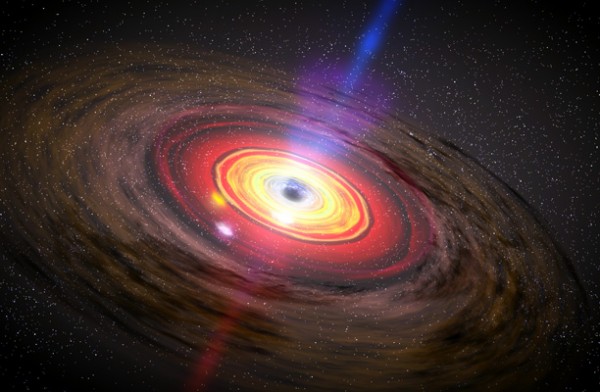
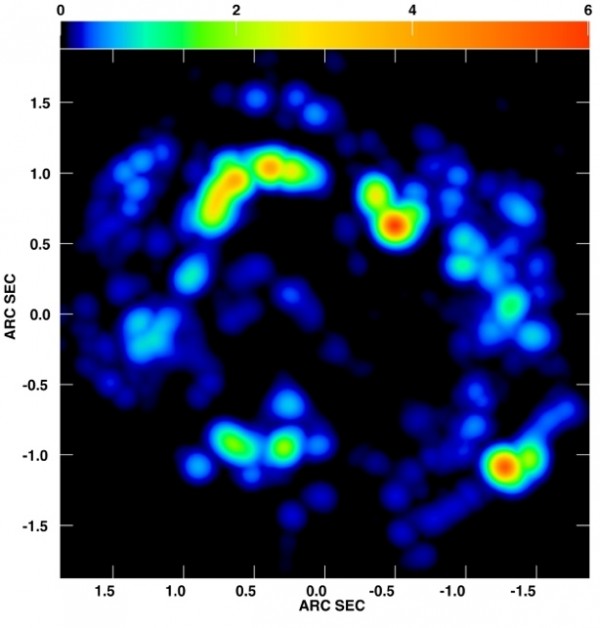

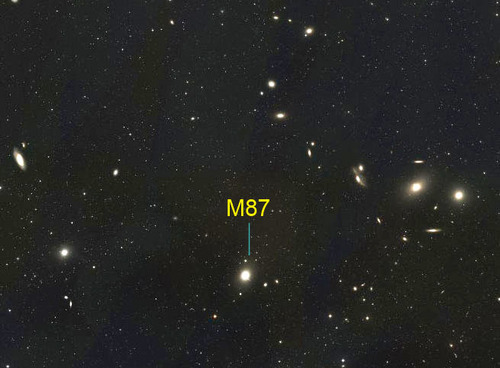
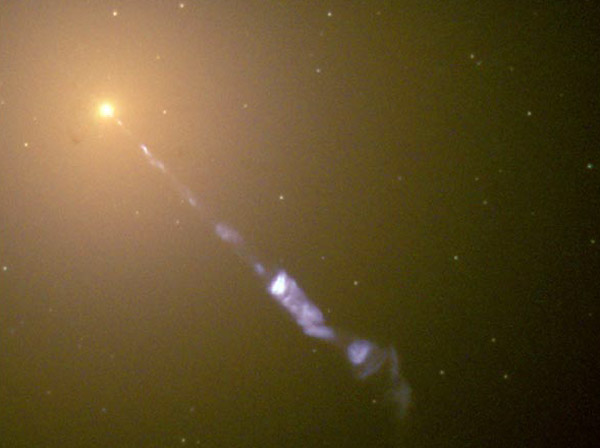
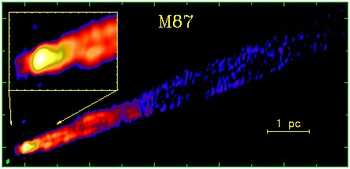
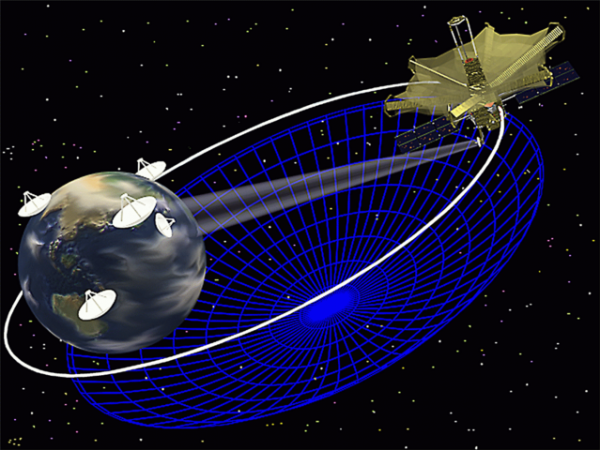
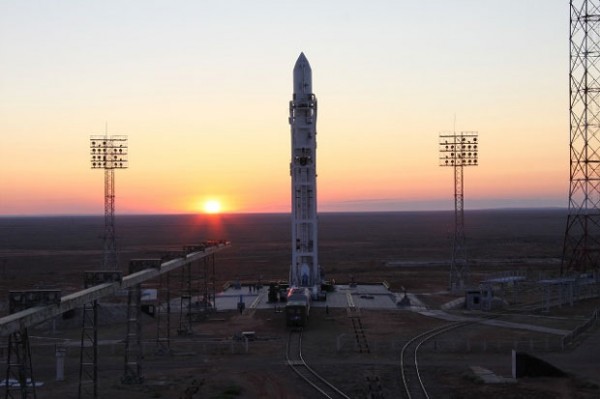
Cool! Can't wait 'till they come in. I'm living my fantasy astrophysicist life vicariously through this blog.
Holy crap. We get to look right at the maw of a monster.
Excelsior!
Pictures. We wants them.
Not just cool, supah dupah cool!
And I was curious about the asymmetrical jet on M87. Is there really only one or can we just not see the other in this picture?Guessing because of relativistic speeds away from us?
(I'll just go google it, but I kind of miss just talking about space stuff with other humans. I have a BS in astrophysics but am somewhat trapped (temporarily, hopefully) in the pharmaceutical industry at the moment. Ugh.)
That's insane! How did I not hear about this sooner? Can't wait for results!
(Meanwhile, my own nation's government is considering canceling the Webb telescope. Where's the motivation of a nice cold war when you need it?)
Thanks. I was wondering why I'd only read about this at the BBC. None of the other usual suspects seem to have mentioned it.
I'm still hoping for a big radio scope on the Moon, though.
(Of course, I'm also hoping for twin scopes in the Jupiter Lagrange points for parallax measurement, so I admit to being a tad nuts.)
I can not even describe how incredibly awesome this sounds. Observing the unobservable. :)
I am with all the other people, just agog at the possibility and amazed with the rapidity that all this has occurred. I was privileged to be a Berkeley boy and played with the son of Glenn T. Seaborg. I remember Glenn himself. Needless to say, I was aware of nuclear fission and fusion in the middle fifties, still in grade school. Then sputnik and the space race. While I am not that happy with how we have mishandled space, I am very pleased that we may get a look at a singularity's boundary state.
What has happened in my lifetime of 65 years indeed seems too much for one person to keep pace with. I saw where they found a new particle, predicted and now discovered in its aftermath, a heavy relative of the neutron, a sub-b, built of a strange, up and bottom quark - the bottom giving the particle its heaviness. So the very large and the very small is just a poppin.
Thanks for the explanation.
The Wired link is broke.
Wow. The Russian Radio Telescope Radiostrom has such an ambitious scientific program; follow Ethan's link to the description.
Thanks!
WANT.
I can't wait to see those results .
When when when do they expect the first pictures to come back?
About the cold war - we'll have to convince al qaida to join the space race!
No, seriously: I'm not wanting to see something that has an event horizon - wouldn't you have to be within that event horizon to actually see something?
"well, guess what launched on Monday?"
Me on tram full of people- "Oh Snap!"
It is so interesting!! Check what I found here: http://www.webofstories.com/play/9543
John Wheeler tries to explain how the collapse of matter into a black hole works. So cool!
http://s12.photobucket.com/albums/a221/jlehane3/?albumview=slideshow The slideshow is people,animals,Cliff sculpted 10 foot tall FACES,fossils @Mars.I designed then Mars rovers 1987/originator. When I sent the drawings to Gene Roddenberry(Star Trek) I also sent the drawings for the current model dual jets for black holes.I also added that multi-band imaging would be required because optically the black hole is obscured by swirling dust,during the breakdown of matter process and shot out the jets as gasses and smaller bits(ripped apart)and EJECTA at high speeds like a dual sided volcano.
When the picture of the Hubble Deep Field came out, I thought it was a collage, and still thought so long after the Ultra Deep Field picture came out. So I ignored it.
Thanks to Ethan, I shall not be fooled over this.
When the picture of the Hubble Deep Field came out, I thought it was a collage. So I ignored it.
Thanks you, Ethan, I shall not be blase over this.
Oooh, the black hole drama is still alive. So called black holes exist as nothing more than empty holes of nothing. Empty space is what you'll see. If you're lucky you'll get a glimpse of another galaxy "through the loophole."
:)
Thank You for this great post. The further we look into space the stranger it appears but at the same time wondrous. I also ponder the origin of the Universe and what happend in the first few seconds...and when did black holes first appear.. are we of star formation and from a black hole .. the other ideas that really intrigue me are space time dilation and time travel.
@Joffemannen,
We might well be within an event horizon, since the mass of the universe is very close to that required to make the universe a black hole with an event horizon radius of about 14 billion light years. It doesn't look too different from here.
Really good article, thanks! Can't wait for the next installment...
I thought we already could "see" an event horizon, the biggest one we could possibly measure. Dark energy?
I was reading an article on the RadioAstron recently; I hope everything goes well and the folks who came up with the idea get to see the results. The instrument was proposed and some work started many years ago, but apparently the project was put on hold and somewhat recently has got funding to go ahead.
On earth the largest radio array in the works is the Square Kilometer Array, but thanks to numerous delays and a few unresolved technical issues (not impossible technical issues but certainly costly) I'm becoming cynical that even the SKA 10% demonstrator will pull through.
What about the plans for VLBI of Sgr A*?
@wayne highwood,
Dark energy isn't seen. Like dark matter and inflation, it is just inferred. Without these inferences, general relativity has some problems, and we aren't ready to give up on it yet, until we have something better. GR will always be a good for many purposes, just like the flat earth theory is good enough for many architectural and engineering projects.
Ethan,
A picture with a resolution of 7 micro arcseconds has pixels that are 21 billion kilometers wide (at the distance of 53,000,000 LY). However, a black hole that is a thousand times as massive as our galaxy's BH has an event horizon that is 24 billion kilometers wide. How can a picture present an image of something that is about the size of a single pixel?
@Ethan,
Correction to my comment above: If M87's black hole is rotating fast, its event horizon could be up to 48 billion kilometers wide. That would be 2 pixels wide instead of one.
A "black hole of 6 times 10^9 solar masses" has an event horizon radius of 1.772Ã10^10 kilometers, which would put its diameter at 35.4 billion km (non-rotating). The figure I get for the "sin(7 micro arc seconds) times 53 million lightyears" is about 17 billion km. The phrases in quotes can be put into wolframalpha, without the quotes, and it will perform the calculations.
Exciting news and great explanation. It suggests that there are other approaches to astronomy using very long baselines and apparatus scaled to the magnitude of space. What other possibilities await us once we can routinely and economically escape the gravity hole of earth and become more familiar with engineering in deep space? Let's ditch these dinky rockets and start constructing our launch vehicles at full sized ship yards. Cheers.
We will have to wait for a few months before we see the pictures we all want to see. For the first 3 months RadioAstron will be going through the engineering testing phase, next 3 months - imaging of well-known objects to test/calibrate the equipment. After that - full-on science!
At pluto's distance, RadioAstron will have a resolution of 169 meters.
http://www.wolframalpha.com/input/?i=sin%287+micro+arc+seconds%29+times….
I doubt that pluto is a radio emitter, but is there ambient radio illumination, i.e., will RadioAstron be useful at all in studying pluto?
At pluto's distance, RadioAstron will have a resolution of 169 meters.
http://www.wolframalpha.com/input/?i=sin%287+micro+arc+seconds%29+times….
I doubt that pluto is a radio emitter, but is there ambient radio illumination, i.e., will RadioAstron be useful at all in studying pluto?
OK, Why was this one held for approval?? It has only one link??
Infinite in all directions...but in my lifetime?
So ... its five-year mission is to explore strange, new worlds?
Thank You for this great post. The further we look into space the stranger it appears but at the same time wondrous. I also ponder the origin of the Universe and what happend in the first few seconds...and when did black holes first appear.. are we of star formation and from a black hole .. the other ideas that really intrigue me are space time dilation and time travel.
Thank You for this great post. The further we look into space the stranger it appears but at the same time wondrous. I also ponder the origin of the Universe and what happend in the first few seconds...and when did black holes first appear.. are we of star formation and from a black hole .. the other ideas that really intrigue me are space time dilation and time travel.